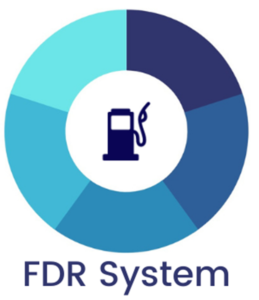THE COMPETITION
Unique technique and product.
Nowadays, there are a wide variety of qualitative methods that allow the detection of micro-organisms in fuels in a quick and easy way. In particular, the water that accumulates at the bottom is where the presence of micro-organisms is greatest.
Generally, one of the best treatments for the control and mitigation of micro-organisms in fuels is good housekeeping practices, such as in-tank cleaning and constant water drains.
However, it is difficult to carry out this type of cleaning on a regular basis, as it entails high costs, in addition to lost sales per cleaning days per year.
In addition, it should be noted that this type of maintenance is considered high risk due to tank degassing and the disconnection of electrical and pneumatic systems, among others. For this reason, this type of maintenance should be carried out inaddition to a microbiological control.
Among the methods used by ESDs to combat background and microbiological contamination problems are the following:
- Microfiltration equipment. These are systems that are installed upstream of the dispenser in order to filter the fuel leaving the storage tank.
- Tank cleaning. Also called dialysis, it consists of the recirculation of the fuel located at the bottom of the tank, using a probe that extracts the fuel and passes it through a series of filters that retain the different contaminants. Finally, the clean fuel is returned to the storage tank.
These methods do not ensure the removal of biofilms adhering to the walls of the storage tank, nor do they ensure the reduction of microbiological the walls of the storage tank and the reduction of microbiological load in the fuel. the fuel.
In our case, we incorporate elements that disinfect the fuel, which is also filtered and passed through the disinfection chamber, so that when it is returned to the tank it carries away all the impurities and microorganisms it may contain.
WHY IS THE USE OF BIOCIDES WORSE THAN OUR PROPOSAL?
Biocides are substances that eliminate or control the proliferation of micro-organisms, but their main advantage is that they also cause various alterations in humans, animals and the environment.
Biocidal compounds are lethal to micro-organisms with varying profiles of action. However, under certain circumstances they are viable for marketing. However, they have the following problems:
- They do not have the same ability to mitigate the concentration of micro-organisms in both the aqueous phase and the fuel.
- They usually have a limited spectrum of microbial activity.
- It has an inhibitory effect in the presence of other substances.
- It is often corrosive to fuel systems.
- Degrades fuel properties.
- They are generally not safe for human use or for the environment.
- They have to be used indefinitely once the problem has arisen.
- It is not possible to use them in all tanks, due to their morphology and location.
- The cost depends very much on how difficult it is to access the tank. For example, it is €30,000 on average for a boat with a 10,000 litre fuel tank.
The main disadvantage is that they do not solve the problem definitively because if a small amount of microbial residue remains, it will reproduce over the months. Therefore, indefinite maintenance after the first detection of microbes is essential.
